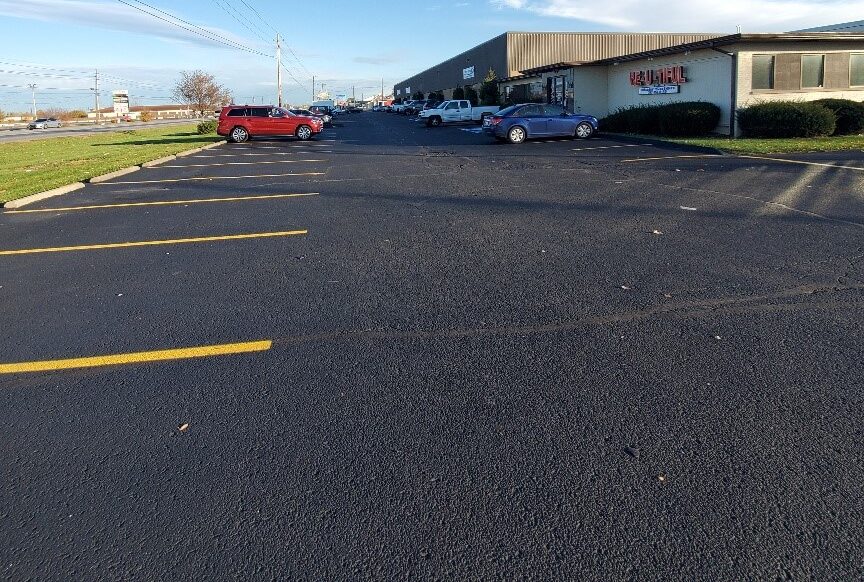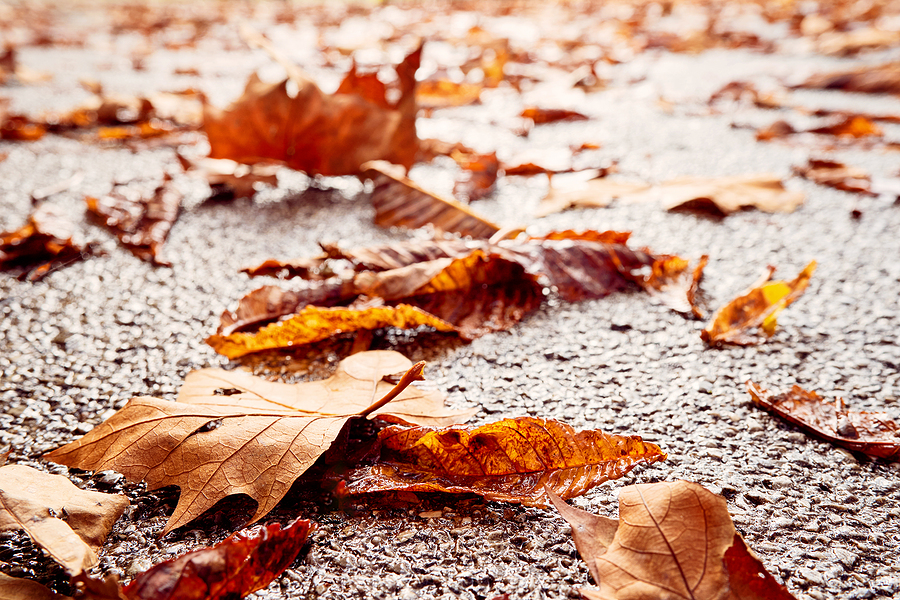An Indiana winter can be unforgiving. The constant freeze-thaw cycles, heavy snowfall, and icy conditions take a toll on more than just our spirits; they can wreak havoc on your commercial pavement. For property owners and facility managers, neglecting winter pavement maintenance can lead to costly repairs and significant liability risks.
Preparing your parking lots, driveways, and sidewalks for the harsh winter months is not just a preventative measure—it’s a critical investment in the safety and longevity of your property. A small crack can quickly expand into a large pothole, and an icy surface can lead to dangerous slip-and-fall accidents.
This guide will walk you through the essential steps to properly winterize your commercial pavement, helping you protect your assets and ensure a safe environment for everyone who uses your property.

Winter Maintenance for Asphalt and Concrete Pavement
Clean & Inspect Your Pavement
The first step in any effective pavement maintenance plan is a thorough cleaning and inspection. Before the first freeze, it’s essential to clear your pavement of all dirt, debris, and vegetation. This allows you to get a clear view of the surface and identify any existing issues that need attention.
Pavement Cleaning
Start by using a power washer or a high-powered sweeper to remove accumulated dirt, oil stains, and organic matter. Pay close attention to drainage areas, ensuring they are free from blockages that could cause water to pool. Standing water is one of the biggest threats to pavement in the winter.
When it freezes, it expands, creating pressure that can cause cracks and weaken the pavement’s foundation. Proper drainage is your first line of defense against the destructive freeze-thaw cycle common in Indiana.
Pavement Inspection
Once the surface is clean, conduct a detailed visual inspection. Walk the entire paved area and look for:
- Cracks: Note the location, length, and width of all cracks.
- Potholes: Identify any existing potholes or areas where the surface is beginning to crumble.
- Faded Pavement: Look for areas where the pavement has turned from black to gray, which indicates the binder is oxidizing and the surface is becoming brittle.
- Alligator Cracking: This pattern of interconnected cracks resembles an alligator’s skin and is a sign of underlying structural failure.
- Drainage Issues: Check for low spots where water collects or areas where runoff isn’t being properly directed away from the pavement.
Documenting these issues with photos and notes will help you create a prioritized repair plan and track the condition of your pavement over time.
Seal Cracks and Repair Damage
Addressing cracks and minor damage before winter is crucial. Even a small fissure can allow water to penetrate the pavement’s sub-base. When that water freezes, it expands by about 9%, exerting immense pressure that widens the crack and compromises the surrounding pavement.
Crack Sealing
For cracks that are ¼ inch wide or larger, hot-applied rubberized crack sealants are the industry standard for winter pavement maintenance. This material is heated to a high temperature and poured into the cracks, where it cools to form a flexible, watertight seal. Its flexibility allows it to expand and contract with the pavement during Indiana’s extreme temperature swings, preventing the seal from breaking and ensuring long-lasting protection.
Pothole and Minor Damage Repair
Small potholes and other surface damage should be repaired before they become larger and more expensive problems. Depending on the size and depth of the damage, repairs can be made using hot or cold asphalt patching materials. Timely repairs not only prevent further deterioration but also eliminate immediate safety hazards for vehicles and pedestrians.
Apply a Protective Sealcoat
After cleaning and repairing your pavement, applying a protective coating is the next vital step. Sealcoating acts as a shield, protecting your asphalt from the elements that accelerate its decay, including water, sunlight, and chemicals.
A sealcoat is a thin liquid layer applied over the pavement that hardens to form a protective barrier. It fills small surface voids, reduces the pavement’s porosity, and restores its rich, black color. The two most common types are:
- Asphalt-Based Sealants: These sealants are emulsion-based and provide excellent protection while maintaining the pavement’s flexibility.
- Coal Tar-Based Sealants: Known for their superior resistance to water, oil, and gasoline, coal tar sealants offer robust protection against chemical spills that are common in parking lots.
Choosing a sealant that can withstand Indiana’s temperature extremes is essential for effective winterizing. A quality sealcoat not only extends the life of your pavement but also makes it easier to clean and sweep, which is a significant advantage during snow removal.

Request an On-Site Pavement Assessment Today! ✅
Plan Your Snow and Ice Management Strategy
Having a proactive snow and ice management plan is non-negotiable for commercial properties in the Midwest. Your strategy should prioritize safety, compliance with local regulations, and the protection of your pavement.
Snow Removal
When it comes to removing snow, your equipment choice matters. It’s recommended to use snow plows with rubber blades or polyurethane cutting edges. Traditional steel blades can scrape and gouge the pavement surface, damaging sealcoats and creating new opportunities for water to seep in. Rubber blades are gentler on the surface while still being effective at clearing snow.
It’s also important to consider where snow will be piled. Avoid blocking accessible parking spaces, curb ramps, or drainage inlets. Piling snow in designated areas away from high-traffic zones and drainage systems helps prevent refreezing on traveled paths and potential flooding issues during thaws.
De-icing Agents
De-icing is critical for preventing slip-and-fall accidents, but the chemicals used can be harsh on pavement and the environment. Here’s a look at common options:
- Salt (Sodium Chloride): This is the most common and affordable de-icer. However, it is less effective at temperatures below 15°F and can be corrosive to concrete, vegetation, and metal.
- Calcium Chloride: Effective at much lower temperatures (down to -25°F), calcium chloride works faster than salt but is more expensive.
- Magnesium Chloride: Similar to calcium chloride in performance, it is generally considered less damaging to concrete and the environment.
When using de-icers, it’s crucial to follow manufacturer guidelines and adhere to local regulations. The Indiana Department of Environmental Management (IDEM) has guidelines to minimize environmental impact, including restrictions on chloride levels in stormwater runoff. Using a blend of de-icers or mixing them with sand can improve traction while reducing chemical usage.
Legal and ADA Compliance
Your snow removal plan must also comply with the Americans with Disabilities Act (ADA) and local ordinances. ADA guidelines require that accessible routes, including sidewalks and ramps, be cleared to a minimum width of 36 inches. Snow and ice must be removed promptly to prevent hazards. Additionally, you are legally responsible for injuries that occur on your property due to inadequate snow and ice removal, making liability a significant concern.
Conclusion
Winterizing your commercial pavement is a proactive process that pays dividends in the long run. By cleaning and inspecting your property, sealing cracks, applying a protective sealcoat, and implementing a smart snow and ice management plan, you can significantly reduce the risk of costly repairs and safety liabilities. These steps not only extend the life of your pavement but also enhance the appearance and safety of your property, ensuring it remains an asset for years to come.
Don’t wait for the first snowfall to think about your pavement. Take action now to prepare your property for the challenging Indiana winter ahead. If you need assistance creating or executing your winter pavement maintenance plan, our team of experts is here to help.
Contact us today for a free service quote and let us help you protect your investment. Partner with us to secure the longevity and safety of your pavement assets throughout the winter season.
Related Post: Winter Pavement Care Tips for Commercial Properties









